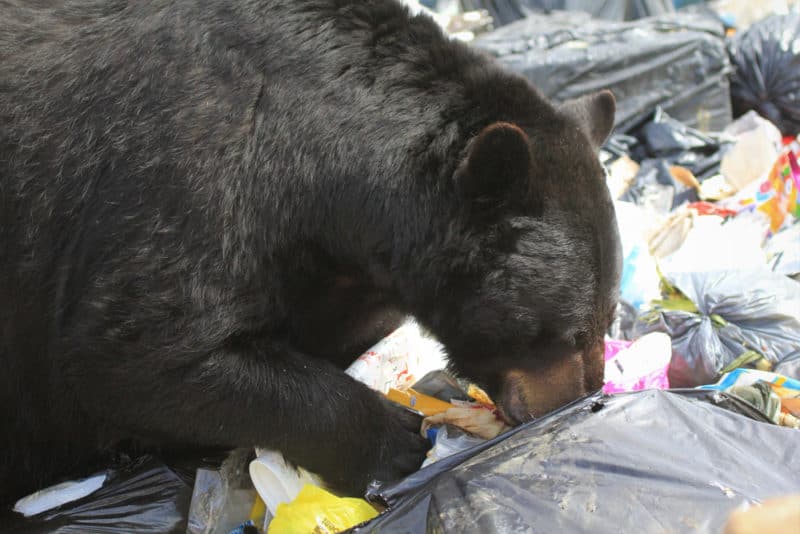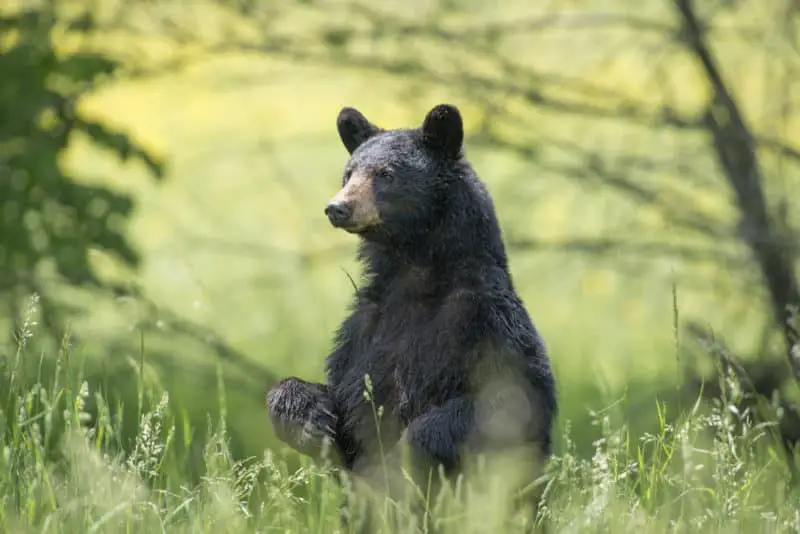The state of Wisconsin is home to the American black bear. In fact, the black bear estimated population in the state is more than 24,000 animals. This gives Wisconsin one of the largest black bear populations in the contiguous United States.
According to the Wisconsin department of natural resources website, bears are more prevalent in the northern half of the state. However, the population has expanded over the last decade, and sightings of black bears are becoming more common in southern Wisconsin.
Wisconsin’s black bears
In Wisconsin, black bears are the third largest mammal in the state after the moose and the elk. Adult black bears are anywhere from 50 to 85 inches long from the tip of the nose to the tip of the tail. Their average height is around 30 inches at the shoulder.
The normal black bear’s weight range is from 140 to 400 pounds. However, large males can be up to 70% larger than adult female black bears, and some giant-sized individuals weigh over 800 pounds. The heaviest black bear ever harvested came from Pike County, Pennsylvania. It weighed 875 pounds.
The pending Wisconsin record black bear was killed in 2020, in Clark County, by 11-year-old Naiya Iraci, its field-dressed weight was 720 pounds, and its estimated live weight was 813lbs.
Even though they are named black bears, their colors can vary from black, blue-grey, cinnamon, brown, blue-black, and on infrequent occasions, a black bear can even be white. Although most Wisconsin bears are black, a small percentage of them are cinnamon colored. Some black bears have a V-shaped white patch on their chest.
They have long brown snouts, short tails, and small brown eyes, although their eyes are blue at birth. Black bears lack the shoulder hump that brown bears or grizzly bears have. In areas that both species inhabit, the hump, or the lack thereof, is a distinguishing feature. Any wild bear in Wisconsin will be a black bear, though.
Where do black bears live?
The black bear’s scientific name, Ursus americanus, means American bear in English. They are the most common and well-known bears in North America. They live exclusively in North America, while North America’s other two bear species, brown/grizzly bears and polar bears, also live in Europe and Asia.
The black bear range begins in Alaska and northern Canada and extends south into central Mexico. Only 9 of the contiguous U.S. states don’t have breeding black bear populations.
Black bears are mostly solitary forest animals, with the exception of raising young. Their home ranges utilize wooded areas and vary in size depending on the density of potential food sources. In Wisconsin, a male black bear will have a home range that encompasses around 27 square miles, while a female will have a home range that covers around 8 square miles. While these animals generally do have home ranges and will defend a food source or a mate if another bear is present, they are not overly territorial and will tolerate the presence of other bears within their home ranges.

How to make your property less attractive to bears
According to Brad Koele, who is a wildlife damage specialist with the Wisconsin Department of Natural Resources, they respond to around 800 bear-related complaints a year. Also, in the year 2020 alone, they trapped and relocated 160 bears. They also euthanized 6 problem bears. See
In drought years, there is a higher likelihood of potential conflicts between bears and humans. Bear sightings in rural and even suburban and urban areas increase significantly in times of drought. Drought stressed bears might wander into areas with higher human populations in search of food.
Another factor that can potentially cause bears to wander is the time of year. When female bears or sows begin to kick their previous year’s cubs off in early summer, young bears, particularly young male bears, sometimes wander great distances looking to establish their own home ranges. At this time, occasionally, they wander into residential areas as they search for their own territory.
Besides being dangerous apex predators, bears can potentially cause significant damage to your home and or vehicles. For example, if a black bear smells food in your parked car, it is capable of tearing the door off to get to it.
If you live in bear country, the following bear precautions will make your property less attractive to wandering bears.
Pet food
It’s a bad idea to feed your outside pets more than they can efficiently clean up before dark. It’s also a bad idea to store your pet food outside. If you store your pet food outside, keep it in a bear-proof container.
Barbeque grills
Backyard barbecue grills are bear attractors. You Should clean your barbecue grill after every use and store it inside. If you live on a large property, dispose of your grease drippings and food waste in an area far away from your home. For the majority of people, though, who don’t live on a large acreage, the best thing to do is to store your grease drippings and meat scraps in the refrigerator until garbage day and then throw it away just before the garbage truck comes.
Trash cans
You should also store your garbage cans indoors and clean and disinfect them regularly.
Garden compost
Garden compost also has the potential to attract bears. Unless you can store your compost under cover, you probably shouldn’t be composting in bear range.
Vehicles
Keep all food or empty containers that have had food in them out of your vehicles. Bears have a powerful sense of smell. Furthermore, as I mentioned earlier, an adult black bear is capable of bending your car door in half if it decides it wants to get inside.
Use electric fencing.
If you have a vegetable garden, a chicken coop, fruit trees, or any other outside bear attractants, you should conder using electric fencing to keep the bears at bay.
Bird feeders will attract bears.
Also, bird feeders have the potential to bring bears to your property, whether that be hummingbird feeders or ones that dispense out bird seed. If you live in bear country, it’s not a good idea to put out birdseed during the warmer months. Wait to feed the birds until the winter when bears are hibernating.
Never feed the bears.
A huge mistake that people sometimes make is to put food out to attract bears on purpose. When you do that, you create a situation that is beyond your control.
When bears begin to associate humans with food, they lose any fear of humans that they might have had. They also might act out aggressively if they decide that you’re not giving them the food that they want and are accustomed to. They might also take that frustration out on your neighbor or, worse yet, your neighbor’s children. Look at the article found here for an example of what I’m talking about.
The best way to make a wild bear into a nuisance bear is to feed it. From there, the chances increase that it will have to be euthanized because it poses a danger to humans.
Bear encounter
The first time you encounter a bear on your property, don’t make it feel welcome. According to the WDNR website, it’s important to harass it. Make loud noises such as yelling, banging pots or pans, or honking an air horn to discourage further unwanted visits. You should never encourage bears to stay on your property. Keeping bears wild lessens the chance of a future dangerous situation.
If bear visits to your property continue to happen, you have a nuisance bear on your hands. It’s time to contact the U.S. Department of Agriculture Wildlife Services Program. They will provide technical advice to best resolve the situation. The USDA wildlife services toll-free line is listed below.
In northern Wisconsin, call: 800-228-1368
In southern Wisconsin, call: 800-433-0663 See

How dangerous are black bears?
The knee-jerk response to that question is that black bears are timid, cautious animals; they’re more afraid of you than you are of them. etc.… All that is true most of the time. However, that’s only most of the time.
The following is from the Krebs Creek article titled Are Black Bears Dangerous to Humans?
“Black bears are not aggressive generally. They’re omnivores, which means their diet includes plant material but also meat. At times, black bear’s diets have been documented to consist of 96% plant material. This makes them one of the least predacious of all carnivores. However unaggressive they might be most of the time, black bears are still dangerous. In fact, at least one person is killed somewhere in North America each year by a black bear.
From 2001 through 2021, Black Bears killed twenty-eight people in North America. That’s a fact that flies in the face of the other points we know about these animals.
According to Doctor Stephan Herrero in his book “Bear Attacks, Their Causes And Avoidance,” from 1900 through 1980, 90% of the fatal attacks by black bears on humans in the United States and Canada were carried out by a predatory animal. In other words, 90% of the time, when black bears attack people, it’s because they view them as a food source.”
I’ll leave off there; if you want to read the rest of the article, you can click on the link.
The point is not to scare the reader. Black bear attacks are very rare. However, we’re dealing with unpredictable wild animals that have the ability to kill you with very little effort if that’s what they decide to do, and in rare circumstances, that’s exactly what they decide to do. Take that into consideration before you feed one.
“90% of the time, when black bears attack people, it’s because they view them as a food source.”
DR. Stephan Herrero “Bear Attacks, Their Causes And Avoidance,”
Bear hunting in Wisconsin
In 2021 129,000 individuals applied for 11,530 available bear permits. The time that it will take to successfully draw a permit out varies with the state’s bear management regions. It will be anywhere between one and twelve years. Bear hunter success also varies between bear management zones but collectively hovers over 40%.
You might also like the following:
Wild Cats in Wisconsin – Krebs Creek
Are there elk in Wisconsin – Krebs Creek
Venomous Snakes of Wisconsin – Krebs Creek
Recent Posts
The only venomous snakes in Washington State are Northern Pacific Rattlesnakes. The Northern Pacific Rattlesnake (Crotalus oreganus oreganus) is a sub-species of the Western Rattlesnake. Anyone...
Skunks are not classified as true hibernators. But they go into a state of torpor when the weather gets cold. Skunks are light sleep hibernators, along with opossums, bears, and raccoons. ...

